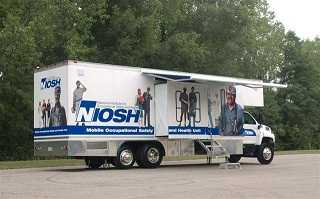Respiratory Health Division (RHD)

The Respiratory Health Division (RHD) provides national and international leadership for preventing work-related respiratory diseases and optimizing workers’ respiratory health by generating new knowledge and transferring that knowledge into practice for the betterment of workers. RHD delivers resources, products, and services to those in need and to those who can effect prevention. RHD has a multidisciplinary approach and specializes in identifying, evaluating, and preventing a spectrum of work-related respiratory diseases, such as work-related asthma, chronic obstructive pulmonary disease, and pneumoconiosis.
Spotlight
Division Reorganization
A reorganization has officially been approved changing the Division of Respiratory Disease Studies (DRDS) name to the Respiratory Health Division (RHD). The DRDS name dates to 1976, when the Appalachian Laboratory for Occupational Respiratory Disease (ALFORD) was reorganized. The DRDS name reflected its focus on protecting workers from respiratory hazards, with efforts at the time focused on agents such as coal, silica, asbestos, and endotoxin. In the 40 years since it was established, DRDS contributed greatly to recognition of emerging hazards such as Libby vermiculite, chemicals used in leather sprays, natural rubber latex, nylon flock, flavoring chemicals, and indium tin oxide. DRDS also enhanced the understanding of risk factors for respiratory disease, including exposure-response relationships for many workplace hazards. RHD will always maintain at its core the DRDS mission of protecting workers from diseases caused by respiratory hazards. But the RHD name also reflects our desire at NIOSH to do more than just prevent disease. We want to optimize health, enabling the workers we serve to enjoy their lives to the fullest.
Respiratory Research
In working with internal and external partners, RHD has conducted research to help protect workers from occupational respiratory diseases.
Examples include:
Various areas of studies include exposures to:
Field Studies
Under the NIOSH Health Hazard Evaluation Program, RHD responds to requests from employers, current employees, or their authorized representatives, to conduct on-site investigations of reported respiratory hazards in their workplaces. This work includes evaluation of the frequency and severity of specific respiratory diseases using epidemiological methods, environmental assessments, industrial hygiene sampling, medical testing, laboratory research, and data analysis. Findings of investigations allow RHD to provide workplaces with appropriate recommendations for prevention. RHD health hazard evaluations have included investigations of:
- Workplaces using diacetyl and related flavoring chemicals
- Dampness in nonindustrial buildings and schools
- Tuberculosis in homeless shelters
- Dust exposures to flock production workers
- Exposures in indium tin oxide production facilities
RHD also carries out experimental field studies designed to address questions such as work-relatedness of diseases, to characterize potentially hazardous exposures, and to test the effectiveness of preventive interventions.
Respiratory Surveillance Program
RHD collects, analyzes, and disseminates information related to the occurrence of occupational respiratory disease, as well as the frequency and time-based trends of specific diseases by agent, occupation, industry, geography, and demographic characteristics. Surveillance products include the Work-Related Occupational Respiratory Disease (WoRLD) Report, the National Occupational Respiratory Mortality System (NORMS) and others. The program develops and evaluates surveillance methods for data collection, processing, and statistical analysis, and provides technical assistance and recommendations for medical screening and health surveillance.
Coal Workers' Health Surveillance Program
The Coal Workers' Health Surveillance Program (CWHSP) was initially established in 1970 by the Federal Coal Mine Health and Safety Act of 1969. In accordance with the Mine Safety and Health Administration’s recently published rule on respirable coal mine dust exposure, the CWHSP provides the following services:
- Health Screening for Coal Miners
CWHSP provides U.S. coal miners with the opportunity to undergo health screening for respiratory disease with respiratory symptom questionnaires, chest radiography, and spirometry (a type of lung function test) at first entry into coal mining and at intervals thereafter throughout their coal mining careers. Medical facilities must be approved by NIOSH for participation in CWHSP before they can provide services to coal miners under the program.
- NIOSH B Reader Program
The B Reader Program aims to create and maintain a pool of physicians who are able to "classify" chest radiographs for the presence and severity of changes associated with pneumoconiosis (dust-induced lung disease) using the International Labour Organization’s classification system. It accomplishes this aim by providing learning opportunities and examinations that document physicians’ abilities to use the classification system.
Enhanced Coal Workers' Health Surveillance Program
NIOSH, in collaboration with MSHA, has developed, staffed, and implemented an Enhanced Coal Workers' Health Surveillance Program (ECWHSP). The ECWHSP uses a specially designed mobile medical examination unit staffed by trained personnel to conduct surveys across the nation at times and in locations that are convenient to coal miners. Screening includes work histories, spirometry testing, and chest radiographic examinations. Reports of individual health findings are sent to each participant.
NIOSH Spirometry Training Program
The Occupational Safety and Health Administration (OSHA) Cotton Dust Standard [29 CFR 1910.1043] assigned NIOSH the responsibility of approving spirometry courses developed to train technicians who perform spirometry under the Standard. The purpose of a NIOSH-Approved Course is to improve the quality of testing by assuring that technicians who perform spirometry have received sufficient theoretical and hands-on training. NIOSH-approved spirometry training courses are recognized for their quality and are attended by technicians performing spirometry in a variety of settings.
- Page last reviewed: May 20, 2011
- Page last updated: September 29, 2015
- Content source:
- National Institute for Occupational Safety and Health Office of the Director


 ShareCompartir
ShareCompartir